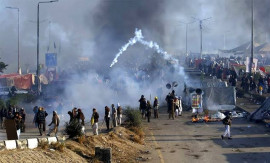
Just 11km east of Bahawalpur is the shrine of the Sufi, Mohkam Din Sairani. As much as I am tempted to talk about his legacy, my mind is distracted by heaps of garbage around the shrine and in the streets of the town where it is located. Just like clocks stop dead, the local municipal services no longer deliver in this town of over 60,000 people. The last time I saw such spectacular filth was in Amritsar. Talk to the people and you will discover that it is not the clocks that have stopped but the leadership that does not care to deliver.
While people’s dissatisfaction with the current Akali-Dal leadership is rife in India’s Punjab, whom ordinary people hold responsible for the poor state of affairs, including for drug proliferation, there is a similar creeping dissatisfaction with the mandate given to the PML-N in south Punjab. Khankah Sharif, Bahawalpur, is just such an example of how development has not reached the sub-region despite the PML-N getting an impressive mandate in 2013. This is also where the problem with south Punjab lies. The centuries of authoritarianism mean that people vote based on, not whom they feel to be the right person, but on where the political wind is blowing. For instance, in the 2013 elections, the town of Khankah Sharif did not vote for the PPP candidate, who had done comparatively more work since 2008 than his competitors in bringing utilities to the area, but for the current national and provincial assembly members from the ruling party just because the wind was blowing in favour of the PML-N. Not surprisingly, the entire south Punjab belt is intently watching how the Panama leaks affair unfolds because its outcome will determine yet again which side the power centre favours.
Lest someone thinks that the problem is only in this particular constituency in south Punjab, others are equally bad. In most cases, the response from elected members or their minions is that the provincial Sharif government holds resources to its heart. Since development funds are not readily available, elected members are unable to show performance. There is also a lot of talk about the local government system not being activated despite holding of the LG polls due to funds being utilised for the Orange Line project. With excessive focus on developing infrastructure, there is little attention given to grassroots development. Ordinary people want more than solar power projects. They need roads, sanitation, clean drinking water, schools and accessibility of their leaders through whom they can approach the state bureaucracy (not their minions). One of the reasons Jahangir Tareen, for instance, lost in the past was the accessibility factor. People would rather trust the devil they can reach and converse with than the one whom they can’t even touch (the distance from the main road to Tareen’s throne may seem like a million miles. How he won in a re-election remains a mystery).
But is it really that PML-N parliamentarians and provincial assembly members from south Punjab don’t get resources? Travel around the sub-region, which is big enough to become an independent province, and you will feel the difference. In Bahawalpur, for example, the areas with Punjabi population get comparatively more development funds than their Seraiki counterparts. The clannish/ethnic mentality of the Punjab government clearly reflects a bias, which makes the Seraiki population unhappy. The dissatisfied constituents ask minions of their elected members that if Punjabi members can get funds, why can’t the others? There are no answers to this and it will not help the PML-N in future. The local grapevine does not bode well even for sitting ministers. The chances of re-election of many are dismal. Some of the ministers tend to hide from the constituents mainly because they are unable to effectively bring development projects. There is also the sense that the central Punjab-urban-based political leadership benefits the Punjabi mercantile class at the cost of the south Punjab-based agricultural sector. There appear to be more benefits for south Punjab under the PPP than under the PML-N. Under the circumstances, south Punjab seems to be slowly reviewing its affiliation with the PPP. It is the absence of a grassroots organisational structure, which is one of the biggest challenges for the Bhutto-Zardari party. The recent mass mobilisation in Rahimyar Khan indicates a support base for Makhdoom Ahmed Mehmood, and rising frustration of the Seraiki population with the current state of affairs. The Punjabi-Seraiki friction in Rahimyar Khan is noticeable. This is not to suggest that the PPP can make a complete comeback in the next elections, but that it has started to breathe again in south Punjab. Greater footwork at the grassroots level, giving a clearer policy on making of a new province, plans focusing on developing south Punjab and an efficient re-organisation can change things. At the moment, no one can say that the PPP is entirely dead in this region. There are even those who are happy not to entirely abandon Asif Ali Zardari.
A question that urbanites from other parts of Punjab will naturally ask is that why not the PTI? The answer is that Imran Khan’s party in south Punjab is just like Arvind Kejriwal’s Aam Aadmi Party in India’s Punjab — it has traction in urban areas but has little sense of rural areas and their population. The party had made bad partnership choices in the 2013 elections mainly because it outsourced the work to Makhdoom Shah Mehmood from Multan who didn’t reach out to the people and depended more on his familial-feudal linkages. Talk to the man on the street in south Punjab and he, just like people in interior Sindh, will tell you that the PTI does not exist in their midst. Observers will frown at the ‘backwardness’ of these people and their illiteracy. But what is actually worth a scowl is the arrogance and retrograde politics of those that spin a web of post-colonialism around the people and society at large. Common people are invested in a patronage-based system because the rulers, which includes the bureaucracy, have never made the state subservient to the people. The prevalent formula is based on the premise that it’s the people for the state and not visa versa. But even within this framework, people search for optimal gains. Let’s see in which direction south Punjab swings in the next elections.
Published in The Express Tribune, April 21st, 2016.
Like Opinion & Editorial on Facebook, follow @ETOpEd on Twitter to receive all updates on all our daily pieces.




















1713350999-0/Tribune-Collage-Feature-Images-(5)1713350999-0-270x192.webp)






















COMMENTS (11)
Comments are moderated and generally will be posted if they are on-topic and not abusive.
For more information, please see our Comments FAQ